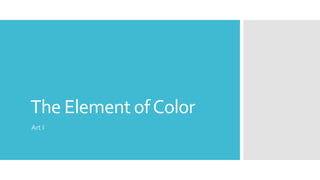
Color theory
- 2. Color Color immediately attracts attention. It is one of the first things we see. Very young children will group objects by color instead of size or shape. An interior designer may use rose-red walls to increase emotional warmth or use blue walls in a daycare to encourage calm. BrightYellow and Magenta may make an poster more eye-catching with contrast. Color is a very complex but powerful Element of Art & Design .
- 3. Color theory Color theory is the art and science of color interaction and effects. In The Art of Color, Johannes Itten lists the following approaches to color theory. Physics Chemistry Physiology Psychology
- 4. Approaches to ColorTheory The physicist studies electromagnetic wavelength in order to measure and classify color. The chemist works with the molecular structure of dyes and pigments, and seeks to produced highly permanent colors and excellent paint consistency. The physiologist investigates the effects of color and light on our eyes and brain The psychologist studies the expressive effect of color on our mind and spirit. .
- 5. Artist Application of Color The artist needs to take all of the approaches into consideration when using color. Like the physicist, the artist uses color wavelengths to create various effects Like the chemist, the artist must be aware of the safety and permanence of dyes and pigments. When using color to create the illusion of space, the artist puts into practice theories developed by physiologist. Communication and Expression are strongly affected by the psychological effects of color
- 6. The Psychology ofColor in Logo Design Infographic by LogoCompany
- 7. ColorSystems The two major color systems we use are: Additive Colors (RGB) Created using beams of light Subtractive colors (RYB) Created when white light is reflected off a pigmented or dyed surface
- 8. Additive color Additive Colors are created using beams of light. The primaries of Additive Color are Red, Green, and Blue. Green + Blue = Cyan Red + Green =Yellow Blue + Red = Magenta Red + Green + Blue = White The colors you see on a computer, television screen, and projection are created by light. Used by Lighting Designers,Videographers, andWebsite Artists.
- 10. Subtractive color (RGB) Subtractive Color is created when white light is reflected off a pigmented or dyed surface. The primaries of subtractive color are Red, Yellow and Blue. A Red surface absorbsYellow and Blue Light and reflects Red. AYellow surface absorbs Red and Blue Light and reflectsYellow. A Blue surface absorbs Red andYellow Light and reflects Blue. AWhite surface reflects all light. A Black surface absorbs all light.
- 11. Subtractive color (RGB) Used by Painters, Printmakers, and Illustrators in various media – acrylic paint, oil paint, pastels, ink, etc. Each pigment or dye used to make these materials are unique. Can be transparent or opaque – will affect blending and layering Adding color overtones and values will increase varieties of color. ColorOvertones are a secondary hue bias in the primary color. For example, Alizarin Crimson is a red with violet overtones, while scarlet is a Red with orange overtones. Achromatic elements, such as Black andWhite, (non-colors) add value to colors.
- 12. Process colors (CMYK) Process colors are a subtractive color system that we use in print media. The Primaries of Process colors are Cyan (Blue), Magenta (Red), Yellow, and Black The process color system is typically used for mass production. Each color is laid down on the paper through a separate roller. The final image is created as the colors overlap. Cyan Magenta Yellow Black
- 13. Color Separationin CMYK Printing Dots of cyan, magenta, yellow, and black are layered to create a full color image.
- 14. Color interaction Color interaction is the way colors influence one another. Colors are never seen in isolation. Depending on the associations we have with a color, lighting, and the surrounding colors, our perception of the color is affected. A blue sheet of paper may remind us of the sky or the ocean. Incandescent lighting may create a warm orange glow. A blue sheet of Paper next to an orange sheet seem more vivid. Simultaneous contrast refers to how the perception of a color is altered by a surrounding color.
- 15. Exampleof Simultaneous Contrast Each Pair of Boxes have the same color in the center, but the colors appear different due to the surrounding colors.
- 16. Defining colors (onthe colorwheel) Hue is the name of a color, determined by its wavelength. This excludes non-color (black/white) In the Johannes Itten ColorWheel (for subtractive colors) Primary colors are Red,Yellow, and Blue They cannot be created by mixing. Secondary Colors are Orange, Green, andViolet They are created by mixing two primary colors. Tertiary Colors are Red-Violet, Red-Orange,Yellow-Orange,Yellow Green, Blue-green, and blue-violet They are created by mixing a primary color and a secondary color that are next to each other on the color wheel. The names are a combination of both colors. The Primary color’s name always comes first!
- 17. The 12Step IttenColor Wheel Primaries (inner triangle) Secondary (out triangles) Tertiaries are located between the Primaries and Secondaries on the wheel.
- 18. Color Temperature Color temperature is the heat a color generates, physically and psychologically Usually divided intoWarm colors and Cool colors. Warm Colors – Red-Violet, Red, Orange,Yellow Cool Colors – Green, Blue, Purple Value – relative lightness and darkness of a color
- 19. Value Value – relative lightness and darkness of a color Tint: Hue +White Tone: Hue + Grey Shade: Hue + Black
- 20. Intensity Intensity, Saturation, & Chroma all refer to color purity and affects how bright the colors are. The intensity of the color will decline as more colors are mixed. The primary colors are the usually the most intense. Mixing opposite colors will make a color more dull. High intensity colors are used to maximize impact and are best used when combined with low-intensity colors.